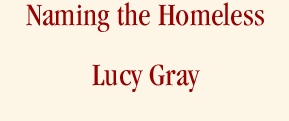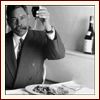|
s t a t e m e n t |
|
Program notes, Grace Cathedral, San Francisco December 1998:
This is a project in which 28 homeless people had their pictures taken where they lived or liked to hang out and again after they had been made over to look like fashion models. There was no satire intended. Rather, the idea was to show these people at their peak. Further, I felt it would be so much easier for the rest of us to care about people, and harder to forget them, once we knew their names. I still believe that, but I have now also to consider the view from the other side. Lawrence Green, the first model who called me after his case worker told him about the project, was upset by the idea that his name might be linked to homelessness indefinitely. “What happens after I get a job?” he wanted to know. “I’ll write ‘Happily Employed’,” I promised. But that was a flip answer. These peoples’ lives are fluid, while the pictures capture and keep a 60th of a second or less. Still, these pictures compare and contrast the documented life to the invented one – the one that might be. Some people whom I asked to contribute money or goods to this project worried about what would happen after the models had been made over and then had to go back to their real lives. These models are complex adults as rich as reality. Just because they are in need doesn’t make them simple. They shoulder extraordinary responsibilities in order to protect their children from dangerous people or, like Mr. Toshi who travels an hour and a half by bus each way to get his son to school each day. Does that mean he can no longer imagine? Take a holiday? Separate work from play? Do we insist that the homeless must be genuinely helpless before we can assist them? There are as many different kinds of homeless individuals as there are housed. I hope this exhibit reminds us that the homeless are not only the people we feel threatened by because they are sleeping in a doorway we wish to enter. Or because they are begging for money. Or that all homeless people become so out of stupidity or shiftlessness. Twenty-five of the 28 people in this exhibit showed up on time and worked well and hard. I defy you to find the one who showed up six hours late and drunk. She’s the one who holds herself like a professional model. But she hadn’t washed her hair in three months and she arrived at Architects and Heroes too late for a cut. She got ugly with the make-up artist who had given her time and materials for free and might have expected some appreciation. But the homeless are people just like paying customers, they have sweet personalities and cruel ones. It’s our vanity that wants people to be grateful for charity. It was shocking, sometimes, to discover how easily some people had reached their predicament. Richard Stephens was once one of the guards who protected President Kennedy. Recently he had been living a happy, productive life in Portland, Oregon, until he got hit by a car one day and had to be hack-sawed out of his driver’s seat. It took him years of hospitalization and therapy to become one of the amazing recovery stories. But he had nowhere to go after he got out of the hospital. He lives with a friend now and needs to work again. He’s got aspirations to teach golf for a living. For fun, on Sunday mornings, he teaches kids to play. I think he’d be good with kids. His case worker, Danielle Lacampagne, at the Veterans’ Administration Compensated Work Therapy Program, talks a lot about the miracle she finds in each of her ‘survivors.’ These miracles are made out of facing hard facts and surmounting them day by day. The social workers I met were unending in the trenches helping to make difficult decisions. Their organizations didn’t want to be thanked in this exhibit. Many helped generously, but should the models be unhappy with the experience the advocacy organizations want that to be my fault, not theirs. I often had to say that before taking the first pictures of someone who had come to me because their case worker had told them about the project. I had originally intended to select the models after having met them and decided that I could make them over. It didn’t work that way in practice. There wasn’t time. There wasn’t a way to meet people. Instead, case workers at various advocacy organizations asked individuals if they’d like to participate, and if so, they called me up. With a few exceptions, I included whoever called me. I simply made an appointment on the spot and went to take their picture. It was impossible to get in touch with many of the models by phone. No none had their own transportation, with the exception of one couple who lived in their van. We should remember how much harder it is for a homeless person to participate in society than it is for us. We should give them double the credit when they do participate. For me, the heart-rending person is Suny H. Roberts. She’s the only model I met on the street. This was in July, when I needed a picture to put on the proposal for this project. She’s the only one who sleeps on the streets and eats at soup kitchens while she waits for her boyfriend to get out of San Quentin, again. Suny has the most beautiful face, life shines out of her. I met her once at the Martin de Porres soup kitchen where she was having lunch. I guess she’d forgotten I was coming because she wasn’t inside the door as promised. Instead, she was sitting at a picnic table hovering over her food with a hood over her head, but still I spotted her in the crowd without trouble. Her small slice of cheek looked like velvet in a row of lettuce. It was that day she took a picture from her pocket revealing a very unattractive, very overweight Sheryl Roberts. That was Suny before the degenerative bone marrow disease that keeps her in constant pain yet somehow ravishing. Suny wants to leave San Francisco. She wants to go somewhere easier. I want to scoop Suny up and give her a place to rest her bones and keep from getting a chill. But I can’t do that by myself. I’m just a photographer who can introduce her to you. This exhibit is one effort in a very large social structure. I don’t want to undervalue this exhibit. I’m proud of the community effort this represents. Grace Cathedral has been astonishing in their caring and skill. I think the pictures challenge our assumptions about appearance. Many of these people have a big gap in their resumes, but so do mothers who take off work when they have children. This project has been called controversial. I should hope so. Grace Cathedral says they are hosting the exhibit in the spirit of open discussion of important issues. I felt the same when I set out to make this project. Having met the models, I have more hopes for their future employment than I did beforehand, but for the rest of us and for potential employers, I hope these pictures stir you up. For good or ill, at last the homeless are then in the forefront of your thoughts. And maybe you’ve got a better way to help.
Naming the
Homeless: Portfolio
Program Notes, City Hall, San Francisco August – September 1999:
Most people who see these photographs think the people in them are lovely. Sometimes the complaint is that the people don’t change enough from street to make-over picture – to begin with, they look too good. Another point that has been voiced is that not all homeless people believe in make-up and pretty clothes. O. K. These 28 models are not all homeless people. They are among the homeless who want to be appreciated for their skills and what they have to offer the community. They want to be a part of it. The obstacles to making this happen are vast. These people are getting training but they need transportation, too. They need the confidence to be persistent and consistent. They need to be hired. Don’t we all? If there is one ultimate goal in this exhibition it is to remind us that these people are our neighbors. We need to remember their names. We need to know them. It took a huge effort from a lot of people to make Naming the Homeless and while we were doing it we all said, if just one person is helped seriously this will be worth it. What we didn’t foresee was the effect the experience was having on us. The production manager, Corey Nettles, left photography so she could go back to school to become a teacher. After Naming her work seemed unfulfilling. The project opened up the world of political journalism to me. I am now working on a project about death row. About a month ago I sent out letters to all the participant models asking how they were doing and whether they’d like to say so on camera for Scott Stender, the man making a documentary about Naming the Homeless. The first call was from Tamieka Alford, who said that she had a satisfying job working with homeless prenatal parents and children. She is getting paid $6.50 an hour. Her son (who was 12 years old when I took Tamieka’s first picture) is doing well. Patricia Davis was the next to call. She, too, loves her work as a counselor for people who are drug-dependent. She makes $8.00 an hour. She told me I could tell Tamieka to call her because her clinic was hiring. I believe Tamieka will stay on the track she started, but the notion of her and Patricia networking had never occurred to me. Neither had I seen how they both could have taken their worst experiences and turned them into the basis for employment. I am deeply admiring of the way they are working to support their children. There is a lot to be learned from these women. I know the many people who gave money and time and clothes and food to make this project will be gratified to hear about any of the homeless models as they strive and develop. I for one am looking forward to the day Catherine Latta finishes her schooling and becomes a nurse. I want to know if Rosemary McCord got into the janitors’ union. I can’t find Larry Edmond. Is that because he finally went home to his family after 13 years away? I’m wondering if Richard Stephens applied to teach at the new public golf course at the Presidio. Everyone I know who was involved with this project is excited and curious when they spot one of the participants on the street. I only hope the models can appreciate how much they have expanded and enriched our lives. Thank you. Keep in touch.
The best way to look at the success of the project is by looking at what has happened to some of the participants in the year since the pictures were taken.-L.G.
Catherine Latta – She was in Raphael House. She has since started the two-year program at Clara House and City College, where she is training to become a Licensed Vocational Nurse. She is a year through the program and very much looking forward to supporting herself and her son in their own apartment while she studies another two years to become a Registered Nurse.
Patricia Davis – She was a heavy drug user, with two children she couldn’t look after. She is now a clean, responsible single mother who loves her job as a counselor to drug-dependent individuals. Tameika Alford – She is a third-generation welfare child. But after having her own baby, she found work as a councilor with prenatal homeless women. She is living in the Cecil Williams Glide Community House and looking forward to becoming a social worker. Lenora Hughes – She was a drug-dependent young woman living from night to night in shelters that kicked her out during the day. Soon after I took her picture, she called to try and frighten me into giving her money. She has recently called again to tell me she’s been through treatment for her drug addiction and she’s doing well.
See also: Naming the Homeless: Portfolio
|



